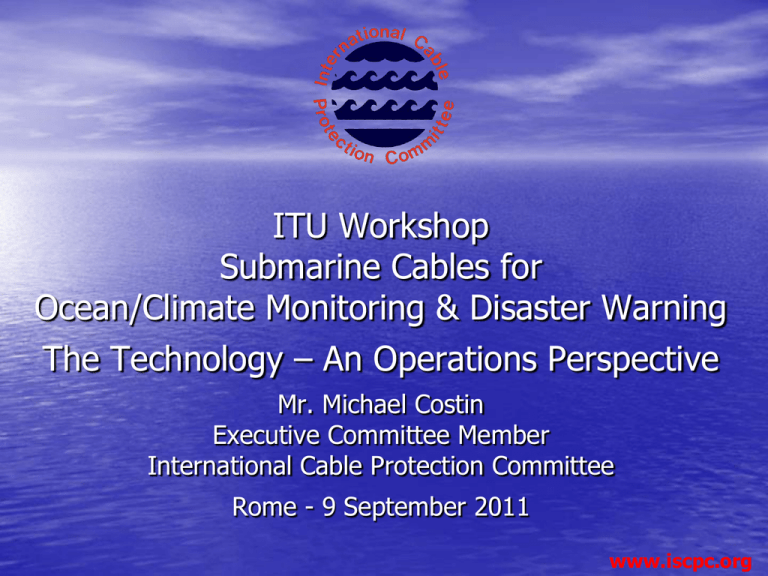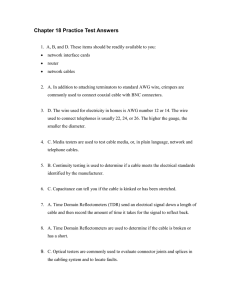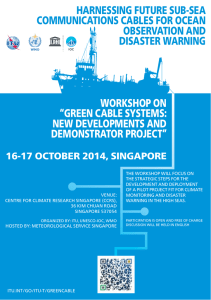ITU Workshop Submarine Cables for Ocean/Climate Monitoring & Disaster Warning
advertisement

ITU Workshop Submarine Cables for Ocean/Climate Monitoring & Disaster Warning The Technology – An Operations Perspective Mr. Michael Costin Executive Committee Member International Cable Protection Committee Rome - 9 September 2011 www.iscpc.org International Cable Protection Committee? • ICPC is an industry body comprising submarine • • cable owners/operators, system manufacturers, service providers and government stakeholders. ICPC supports its members with environmental, legal and technical information and advice ICPC current prime activities are in: – Developing best practice advice – Promoting awareness of submarine cables as critical infrastructure – Monitoring the evolution of international treaties and national legislation to protect submarine cable interests www.iscpc.org The Challenge of Change • Rapid development of offshore renewable energy • Increased incidence of damage caused by shipping • Seabed becoming crowded in some areas • Need to maintain harmony with other seabed users • Need to ensure harmony with seabed environment • Need to improve security of submarine cables • Increased regulation of coastal and high seas www.iscpc.org Typical Submarine Cable System Network Management System Terminal Equipment Armoured Cable Lightweight Cable Repeater Cable Station Source: U.K. Cable Protection Committee & Alcatel-Lucent Submarine Networks www.iscpc.org Submarine Cable Network • Global submarine cable network comprises • • • • hundreds of commercial, independently owned, domestic and international systems International systems can cost up to several hundred million Euros to build. Project development/build takes 2-4 years International consortium formation and funding focussed upon commercial risks. International project development concerned for regulatory and permitting issues www.iscpc.org Submarine Cable Build • Cable operators focus upon routing cables for the: – Safest route to avoid areas of natural (undersea volcanoes) and man-made (designated anchorage and trawl zones) hazards and environmental sensitivity – Shortest possible route so as to minimise latency • Cable operators aim to apply the best cable type for each part of the route, having regard for potential threats from fishing and anchors, whilst minimising cost • Bury the cable into the seabed to mitigate potential threats from fishing and anchoring. New cables target burial up to 3 metres subject to the assessed threat level. www.iscpc.org Threats From External Aggression • Fishing – high • • incidence but impact restricted to individual cables Anchors – medium but increasing incidence that can impact several cables Natural Hazards (e.g. earthquakes) – low incidence but can impact multiple cables % 80 Fishing 60 40 Anchors 20 1960 1970 1980 1990 2000 Cable faults caused by external aggression demonstrate the impact of human activities Base data provided by Tyco Telecommunications & Global Marine Systems Published in Wood & Carter (2008) IEEE Journal of Oceanic Engineering www.iscpc.org Hengchun 2006: An Earthquake that Caused Major Disruption to the Cable Network China • Okinawa Trough • Ryuku Trench • • • Modified from Source: Anderson M., U. Arizona Geosciences (Source: Prof. Lionel Carter, ICPC Marine Environmental Advisor) Earthquake triggered submarine landslides near the junction of 2 tectonic plates. Landslides caused turbidity current that flowed over 330 km & broke 9 cables in sequence. From the timing of breaks, the average speed of the turbidity current was ~20km/hr. Damage occurred in water depths to 4000m - some cables covered with mud from current. Cable repairs involved 11 ships & took 49 days. www.iscpc.org Submarine Cable Operation • Submarine cable system threats can result in a complete cable breakage or a “shunt” fault of the cable’s conductor used for powering repeaters. • Restoration of traffic when a cable breaks or for repair of a shunt fault can take days • Multiple cable breaks can have an impact of several weeks, even several months www.iscpc.org Submarine Cable Maintenance • Cable repair works typically take 7-10 days to complete, but the actual duration of a cable outage will be affected by: – Location of fault relative to the repair vessel – Type of fault (i.e. Shunt or complete break) – Securing any requisite permits/clearances, which can take up to several weeks – Weather conditions • Cable outages can take months to clear. www.iscpc.org Multi-Purpose Submarine Cables • Some power-telecommunications cables • Issue of primary/priority purpose of cable • Cable operators do not repair/replace repeaters with faulted components if the overall system performance is maintained. • If a fault arises with the plant/equipment for the secondary purpose, what priority will its repair have? www.iscpc.org Sharing the seabed in harmony General Enquiries to ICPC: +44 1590 681673 Email: secretary@iscpc.org www.iscpc.org




